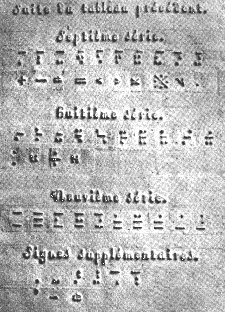Assistive Technology and Universal Design for Learning
Defined and Contrasted
Assistive Technology
Assistive technology has been used since ancient times. Whenever someone picked up a stick to help them walk better, they were using assistive technology. As technology has evolved, many forms of assistive technology have become much more complex. One of the earliest typewriters in recorded history was first introduced by Pelligrino as an assistive device for his friend Countess Carolina Fivizzona. She was visually impaired and needed a method of writing legibly. Early examples of assistive technology include wheelchairs, walking assists, Braille, ear trumpets, and many more. AT has now evolved to include all of the low-tech devices of the past, as well as, the latest high-tech devices used in the modern world such as iPads, cell phones, software applications, etc.
 |  |  |
|---|---|---|
 |  |  |
 |
The Technology Related Assistance to Individuals with Disabilities Act of 1988 (Tech Act) defines AT

Assistive Technology Device: "any item, piece of equipment, or product system, whether acquired commercially off the shelf, modified, or customized, that is used to increase, maintain, or improve functional capabilities of individuals with disabilities."
Assistive Technology Service: "any service that directly assists an individual with a disability in selection, acquisition or use of an assistive technology device."
Individuals with Disabilities Education Act
Assistive Technology Definition (further defined)
-
§1401(B) Exception - The device definition is the same as above, however, has an exception. It does not include a medical device that is surgically implanted or the replacement of such device.
-
§1401(2) Term Addition - The service definition includes the evaluation of the needs of such child, including a functional evaluation of the child in the child's customary environment; purchasing, leasing, or otherwise providing for the acquisition of assistive technology devices by such child; selecting, designing, fitting, customizing, adapting, applying, maintaining, repairing, or replacing assistive technology devices; coordinating and using other therapies, interventions, or services with assistive technology devices, such as those associated with existing education and rehabilitation plans and programs; training or technical assistance for such child, or, where appropriate, the family of such child; and training or technical assistance for professionals (including individuals providing education and rehabilitation services), employers, or other individuals who provide services to, employ, or are otherwise substantially involved in the major life functions of such child.
-
§300.34(b) "related services" do not include a medical device that is surgically implanted, the optimization of that device's functioning (e.g., mapping), maintenance of that device, or the replacement of that device. For regulatory language related to the routine checking of hearing aids and the external components of surgically implanted medical devices, see 34 CFR §300.113.
UDL
Universal Design for Learning

Universal Design is different from AT from the outset. The goal of UDL is to accommodate the widest range of abilities as possible. Unlike AT, UDL is not designed to be a retrofit for an individual need.
The best example is the use of Universal Design in architecture. When a building is in the concept phase, rather than retrofitting the building to meet the needs of visitors as the need arises, universal design takes into account the vast array of potential user needs and provides everyone building access by design. All who enter the building benefit from the ease of access regardless of ability.
The picture to the left shows a retrofitted ramp for someone using a wheelchair or who has difficulty with steps. The original architect did not consider wheelchair access. A ramp was installed after the need was realized.
Hover your mouse over the ramp and a picture of true Universal Design in architecture will appear. The Guggenheim Museum was designed for all visitors to easily access all of the displays. Universal Design is a concept for accommodating as many users as possible.
UDL and AT
Two Sides of the Same Coin

UDL
AT

Hover over coin to see reverse side.
Within the school environment, both assistive technology and universal design for learning attempt to achieve the same goal; making academics accessible for students.
AT is frequently individualized and will likely stay with the student that it was prescribed for. AT is prescribed based on a need specific to a student.
UDL may meet the needs of each student while simultaneously meeting the needs of all students. UDL is inclusive and universal. Strategies are flexible and accommodating. The learning design may or may not utilize AT in its delivery. UDL may use strategies such as cueing, classroom arrangement, scaffolding, explicit instruction and other learning strategies that are not assistive technology.
Individualized

AT

UDL
Good for All
Universal Design/Rose, Hasselbring, Stahl, & Zabala, 2007

To learn more about UDL watch the video below
and go to www.CAST.org to learn from the originators





